How Much Does a Rat Exterminator Cost?
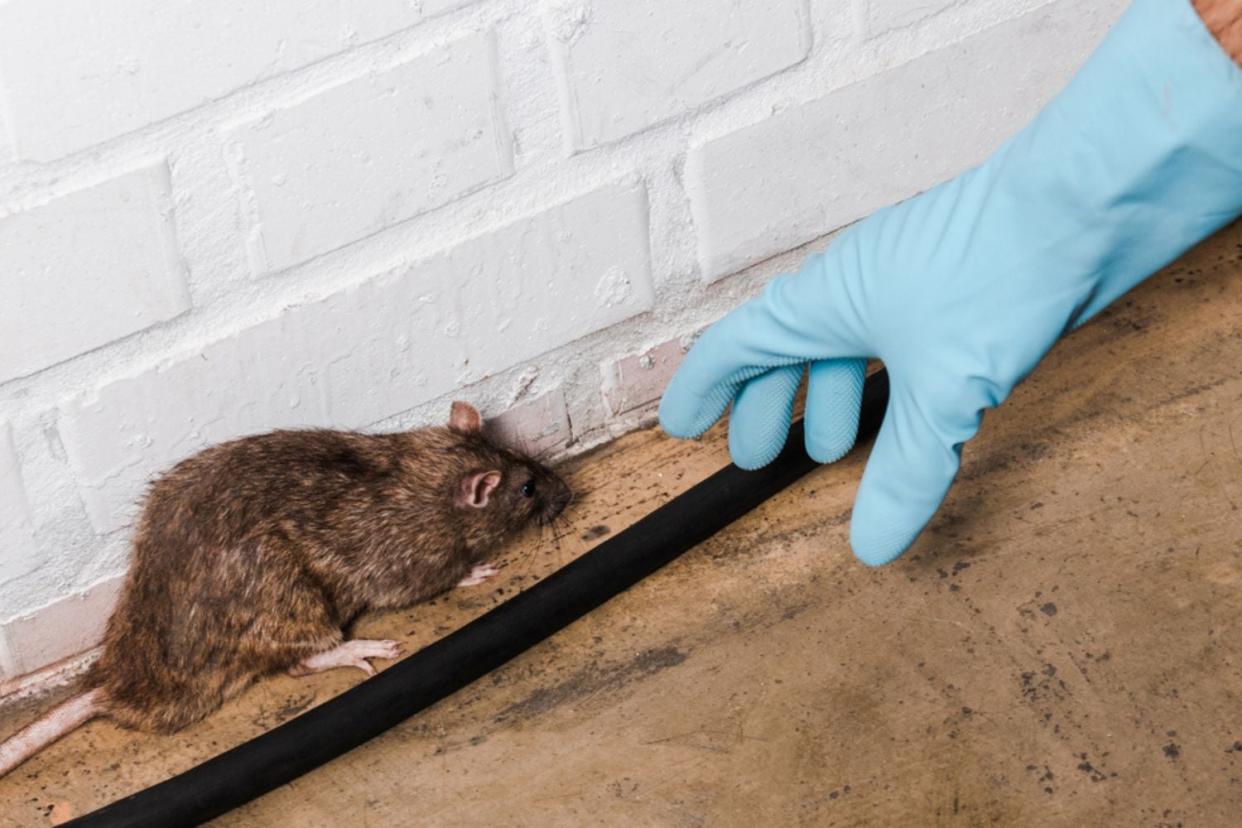
Highlights
The average rat exterminator cost is $377, with a range of $176 to $580 possible for some infestations.
Rat exterminator costs can vary based on several factors, such as home size, infestation location and severity, removal method, extra fees, and follow-up visits.
Signs of a rat infestation that need to be addressed include rat droppings, scurrying sounds, smudges along baseboards, teeth marks on holes, and an unidentified musty odor.
Rats carry diseases and tend to die in inconvenient locations, which makes hiring a pest control company the safest option. Professionals are also the most experienced at locating nests and sealing holes to prevent future infestations.
Finding signs of rats in a home can bring dread to any homeowner. If homeowners suspect there’s a potential sharp-toothed rodent exploring the house, it’s time to call a rat exterminator. Rats can bring with them destruction and disease, making it important to get rid of rats in the home as quickly as possible.
According to Angi and HomeAdvisor, rat exterminator cost ranges from $176 to $580 depending on the size and location of the infestation and the amount of damage they’ve done to the home. To estimate the cost, a rat exterminator will come to the home and conduct an inspection for removing the rodents. The cost of the inspection is often deducted from the final cost of the extermination.
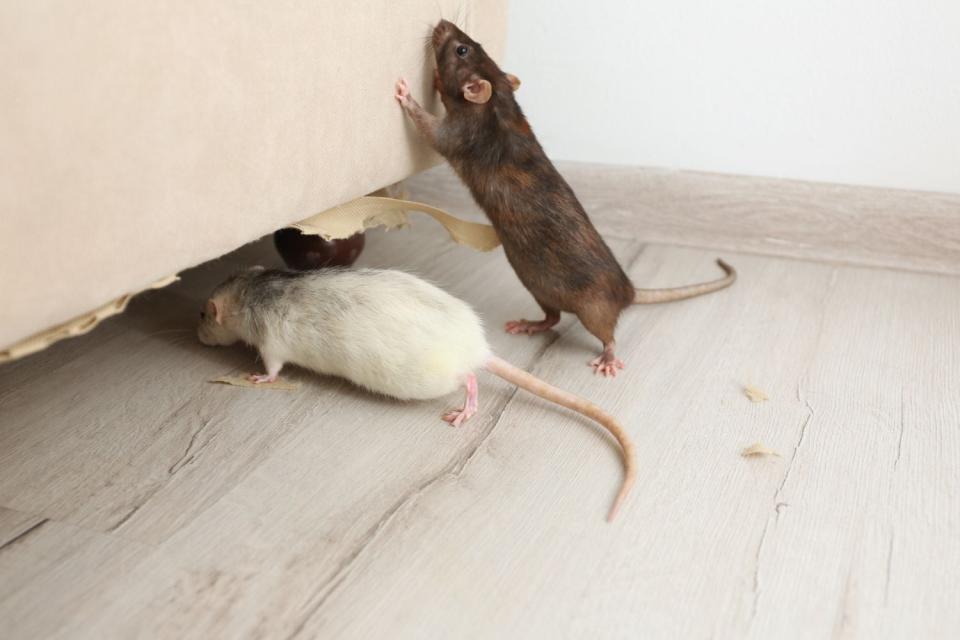
Photo: depositphotos.com
Factors in Calculating Rat Exterminator Cost
Finding or suspecting rats in the home can be unsettling and frustrating, since getting rid of them will become an added expense to the household budget. For homeowners to best understand how much a rat exterminator will cost, it’s important to take into account the size of the home. A large home may have several entry points that need to be sealed and a larger area to be searched to find the rats, which will increase costs.
Other factors that affect rat exterminator cost include the infestation location, the size and severity of the infestation, the extermination company that is selected, the removal method, and the geographic location of the home.
Home Size
The larger the home, the more places rats can enter and build their nests. This means that extermination costs are typically higher for larger homes. Inspections in larger homes can also cost more, as there are more places to inspect. Rat control often involves sealing up entry points, which can take longer to find if the house is large and several entry points are found. Sealing numerous entry points can cost up to $500.
The size of the home can also impact the budget if fumigation is necessary. Fumigation costs between $1 and $3 per square foot, so it will cost more to fumigate large homes.
Infestation Location
If the rat infestation is located in an easy-to-access area like a ground-level room in the home, removal can cost less than if rats are found in a harder-to-access area like a crawl space or in the walls. If signs of rats are found in the ductwork or in the walls, rat removal can require more work, including extensive cleanup and possibly even renovation to repair the damage.
If it’s clear there are rats in the home but the rat exterminator can’t find their nests, the exterminator may need to use thermal imaging to detect areas of the wall, floor, or ceiling that are warmer than others, possibly indicating the presence of a rat’s nest. If thermal imaging detects spots that are colder than others, it can mean that the rats have moved insulation around, leading to uneven temperatures. This may increase the cost of the inspection simply due to the extra time to locate the rat’s nest.
Infestation Size and Severity
A rat infestation in the house can begin small and grow quickly. Rats can produce up to seven litters each year, and each litter can have between five and twelve pups. This means that if rat treatment is delayed for any reason, homeowners could have generations of rats to deal with and more significant damage done to the home. The larger the infestation, the more the rat extermination will cost. A small- to medium-size infestation can cost up to $600, while a severe infestation that requires significant cleaning and renovation can cost upwards of $5,000. This is why it’s important to catch rat infestations early and enlist the help of rat control services as quickly as possible.
Removal Method
For homeowners wondering how to get rid of rats, the answer depends on the situation. A single, easy-to-find rat can be trapped and relocated for a relatively low cost, but a large infestation may require kill traps. In extreme cases, fumigation can ensure that the rats die, but homeowners may find it requires additional work for the exterminator to find and remove the dead animals. To prevent rats from entering the home again, homeowners can consider choosing a comprehensive exclusion service that finds and blocks any possible entry points.
Extermination Company
The rat exterminator price will vary based on location and the size of the company a homeowner chooses. Larger, nationwide pest control companies typically have recognizable names and are experienced in pest control for rats. Homeowners can search for the best pest control companies to find a reputable business like Orkin or Terminix to ensure their rat problem is taken care of fully.
The average cost for single-visit pest control is between $300 and $500 for Orkin and between $400 and $650 for Terminix. These companies often have an easy online form to fill out to request an inspection and rat removal services.
Geographic Location
Exterminator costs also vary depending on the geographic location of the home. The average cost for rat extermination in rural areas and for single-family homes tends to be lower than for rat control in urban areas. That’s because the exterminator will have access to any area in a single-family home, which makes sealing entry points and removing rats much easier than in a high-rise apartment complex.
In urban areas, especially in apartments or condos, rat exterminators may not have access to the entire building. This makes it more challenging to successfully eliminate a rat infestation when rats nest in one area of the building but escape to other areas of the building. If they do catch the rats, exterminators will need to drive farther than they would in rural areas to find a suitable place to release them.
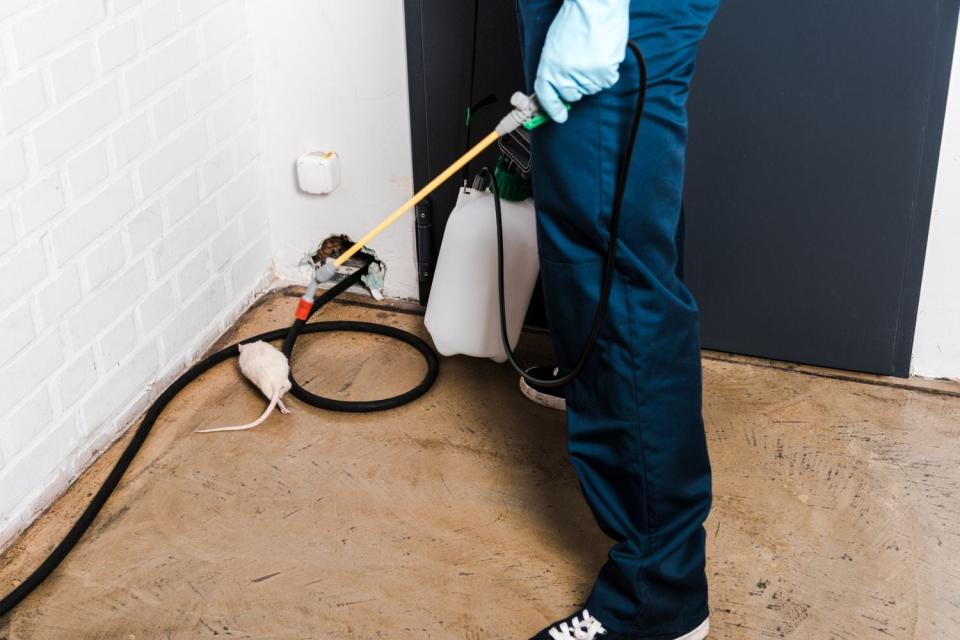
Photo: depositphotos.com
Additional Costs and Considerations
In addition to considering the geographic location, the size and extent of the infestation, and the removal methods, homeowners will need to evaluate the cost of inspection fees, emergency callout fees, follow-up visits, and cleanup and repairs. These factors can add a significant amount to the total cost of rat control, especially cleaning and repair costs if the rats left behind a lot of damage.
Inspection Fees
An inspection to determine the size of a rat infestation, assess the difficulty of extermination, and identify potential causes typically costs about $200, though many exterminators will offer a free home inspection. If the company does charge for an inspection, they’ll likely deduct the cost from the final bill if the homeowner chooses to hire them to do the extermination.
Emergency Callout Fees
If the extermination or even the initial inspection is urgent, extermination companies may charge an emergency callout fee, which can cost $100 to $200 more than a standard visit. Emergency callouts typically happen on weekends and holidays or after business hours. Most instances occur due to an unexpected discovery of a large infestation or a rat that appears aggressive and needs to be removed quickly.
Follow-Up Visits
Unfortunately, as with most other pest control services, rat removal is typically a multivisit process that includes an inspection visit, a treatment visit, and at least one follow-up visit. Regardless of the severity of the infestation, rat exterminators usually schedule a follow-up visit to remove any rats that got caught in the live traps and to check for any new entry points since their last visit.
If the infestation is large, extermination may require multiple follow-up visits to ensure the infestation has been taken care of. While the first follow-up visit may be included in the total extermination price, any additional follow-up visits can add between $50 and $150 to the final bill.
Cleanup and Repairs
Rats that take up residence in a home can do significant damage, even if there are only a few of the pesky rodents. Larger infestations can cause enough damage to warrant home renovations and professional cleaners.
Even worse, dead rats can still pose a danger of spreading disease. If rats are left to decompose in the walls or attic, homeowners can also find their homes overtaken by terrible odors. Additionally, rats can leave behind a mess of droppings and cause water damage if they chew through pipes. Possible repairs from a major pet or rodent infestation include cleaning up droppings, replacing insulation and electrical wiring, repairing plumbing and HVAC systems, cleaning up water and water damage, and repairing the roof.
Type of Cleanup and Repair | Average Cost (Materials and Labor) |
Cleaning | $100 to $200 |
Dead rat removal | $150 to $250 |
Drywall repair | $350 to $800 |
Electrical repair | $150 to $500 |
HVAC repair | $75 to $2,100 |
Plumbing repair | $180 to $450 |
Roof repair | $350 to $1,500 |
Water cleanup | $1,200 to $5,000 |
Rat Exterminator Cost by Removal Method
There are a few different ways to exterminate rats, and the chosen method will affect the average rat and mice exterminator costs. Live traps, or kill traps, are typically the cheapest way to remove rats from the home. Other methods, like fumigation and rodenticide, are typically used for larger infestations and can cost quite a bit more.
Removal Method | Average Cost |
Bait Station | $5 to $15 each |
Exclusion | $200 to $600 |
Fumigation | $1 to $3 per square foot |
Live Rat Removal | $5 to $20 each and $50 per visit |
Rodenticides | $750 to $1,000 |
Bait Station
A bait station contains bait that is intended to kill any rats that eat it. This is a safer option than simply setting out poison because the bait station is self-contained and can’t be opened by kids or pets. In order to access the bait, the rat must enter the bait station and eat it. The rat then leaves and eventually dies. The challenge is that the dead rat should be located quickly so it can be removed before decomposing.
Bait stations cost between $5 and $15 each for professional installation. This price may or may not include the cost to remove any rats that die as a result of the bait station, so homeowners are advised to ask what is included in the price.
Exclusion
Exclusion is a method used to seal entry points and prevent rats from entering the home. Obvious holes are sealed during this process, but it can also include adding screens to crawl spaces or roof vents and cutting back trees that allow rats easy access to the roof. This method costs between $200 and $600 and is often included in the price of rat extermination. Homeowners can ask for an itemized list of what’s included in the quote to know if this service is added.
Fumigation
Fumigation should be the last resort when it comes to rat extermination, as it is both the most severe and expensive method of rat removal. Fumigation involves filling the house with chemicals that will kill the rats. During fumigation, members of the household will have to find another place to stay for a few days while the chemicals do their work.
This method leaves the dead rats in the walls where they could decompose if the exterminator for rats doesn’t follow up and remove them. Fumigation costs between $1 and $3 per square foot, so a 1,500-square-foot house will cost between $1,500 and $4,500 to fumigate—plus the potential cost of alternate accommodations and food for any residents during the fumigation period.
Live Rat Removal
For a more humane rat removal method, a rat exterminator will use live traps to capture the rodents and then relocate them to a rural area from which they’re unlikely to return to their nest. This cost can vary, typically starting at a minimum of $50 per visit to remove and release any captured rats.
Transportation costs to relocate the rats will depend on how far the exterminator needs to go to reach a suitable area. In rural areas, a 3-mile drive won’t take long and can move the rats far enough away that they’ll be unlikely to return. In urban areas, relocation will require driving outside of the city.
Rodenticides
Rodenticides are essentially poisons formulated for rats and mice. They eat the poison and become sick and die, often in the most impossible-to-reach areas behind the walls of the home. Rodenticides can be placed in a bait station or trap and cost between $750 and $1,000 to purchase and have professionally placed in the home. Using this method poses risks for members of the household should they come in contact with the rodenticide. Another danger is that if a pet eats a rat that’s ingested rodenticide, the pet may become sick as well.
Traps
In addition to being caught in live traps, rats can be trapped and killed immediately with kill traps. Electric rat traps use a high-voltage shock to quickly kill the rodent. Installation for these traps costs between $450 and $650, and they should be placed with caution, keeping them away from any place where a child or pet may find them.
Another option that professionals may use is an auto-reset CO2 trap. This will attract a rodent into the trap and immediately break its neck. Unlike a typical mouse trap, the canister used on type of trap will reset automatically, making it easier to eliminate up to approximately 20 rodents without having to monitor it closely.
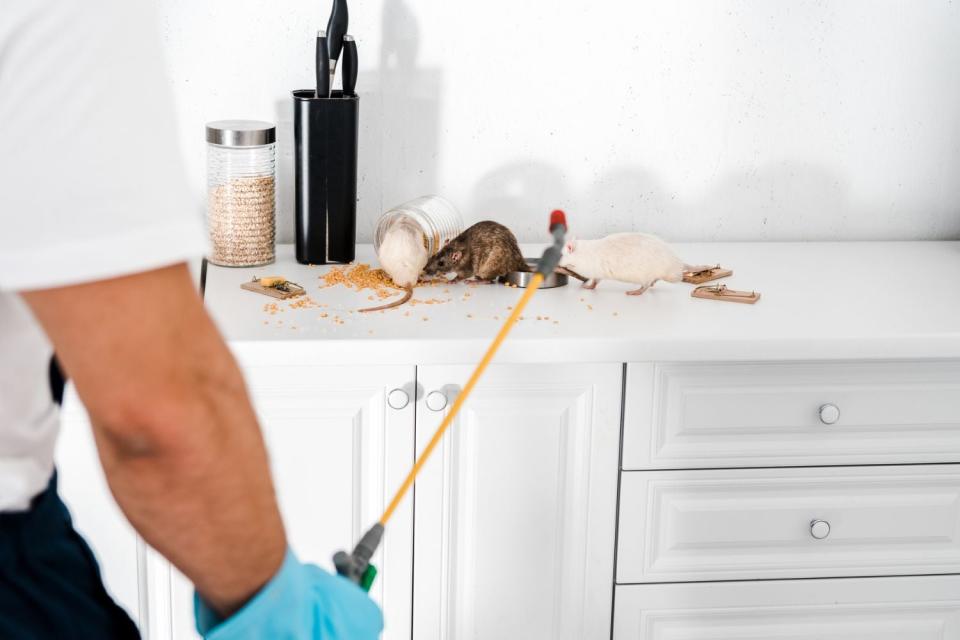
Photo: depositphotos.com
Do I need a rat exterminator?
If homeowners see signs of a rodent infestation in their home, there’s a good chance they need a rat exterminator. Often, rats in a home have built a nest where they will have their babies, which leads to more rats in the home. Rats can carry disease, leave droppings, or chew through insulation, electrical wiring, and even plumbing. Homeowners are advised to remove rats as quickly as possible for the safety of all residents of the home.
Rat Droppings
Rat droppings in the home likely mean there are rats and possibly a full rat infestation. For homeowners unsure about whether they’re seeing mouse or rat droppings, rat droppings are larger than mouse droppings—typically between ½ inch and ¾ inch long. They are often shiny black and found near baseboards or areas with food or crumbs.
Holes or Bite Marks
Rats have incredibly sharp teeth that can chew through drywall, wiring, baseboards, and more. Homeowners who find teeth marks or holes on walls or on corners of closets and cabinets may have invading rats trying to access areas behind the walls.
Smudge Marks or Footprints
Another gross tell-tale sign of rats is a greasy smudge left behind when they run along baseboards. If you notice smudge marks on the baseboards or in any other areas, they could have come from another source like children’s messy hands or dirty pets. Homeowners can narrow down the possible culprits by cleaning the smudges to see if they come back. Another sign is visible footprints in dusty areas, which are likely from rats or other unwanted guests. If you can follow the trail, you may be able to find the entry point.
Shredded Paper, Plants, or Fabrics
Along with chewing through walls and wiring, rats will chew on almost anything else. This includes paper, plants, and fabrics. If you’re finding shredded paper, chewed-up plants, and ripped fabric, you may need to investigate further.
Musky Odor
Rats do not smell good. They give off a musky odor, and the more rats there are, the worse the smell can become. If you notice a musty odor in the home that no amount of cleaning can get rid of, it may be a sign that there are rats living in the home and building their nests.
Scratching Noises
As rats run around looking for food, typically at night, they make scratching and scurrying noises that can keep homeowners awake and worrying about how many have moved in. If possible, homeowners can try to trace the scratching noises to certain areas, which can help locate the nesting area and point the exterminator in the right direction.
Unusual Pet Behavior
Pets can hear things that humans can’t, so if a homeowner’s dog or cat is acting unusual or upset, it may be hearing scurrying, scratching, or squeaking noises and be agitated by the unidentified source. Obviously, unusual pet behavior isn’t confirmation that there is a rat infestation, but it may be a sign for homeowners to be vigilant and look for other signs of rats.
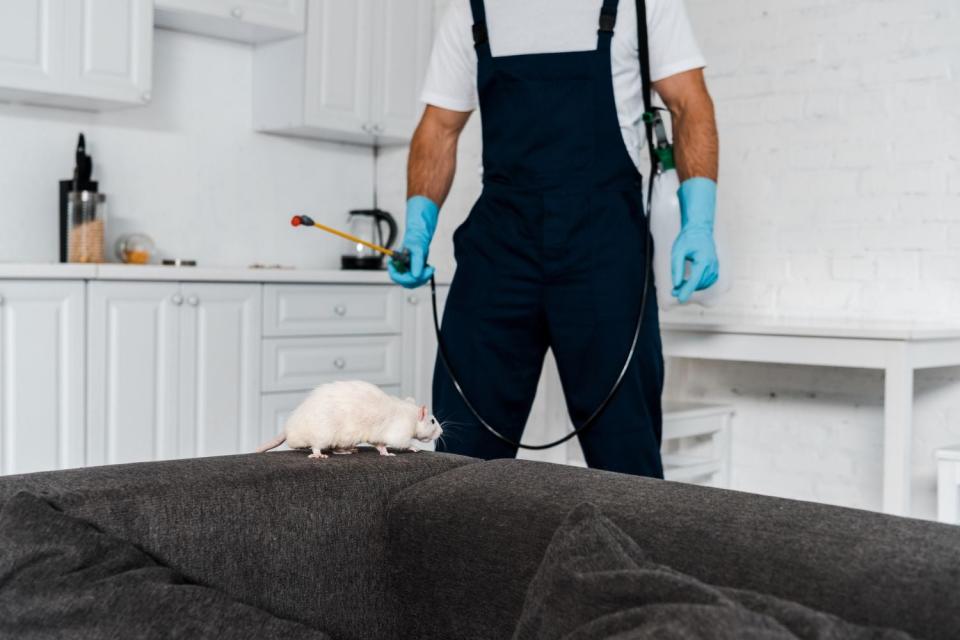
Photo: depositphotos.com
Rat Extermination: DIY vs. Hiring a Professional
DIY rat removal may be cheaper than professional rat extermination, but it can also be a difficult task, and homeowners may not be able to take care of the problem as well as a trained professional. The best mouse exterminators and rat exterminators are skilled at finding even the sneakiest signs of rats and ridding a house of them. Still, there are a few ways that basic DIY rat removal can be done by homeowners as long as they understand the risks.
Live traps can cost between $5 and $20 per trap, but once the rat is caught, homeowners will have to dispose of it miles away from the nearest inhabited house. A pro exterminator has the time and experience to know where to go to save homeowners the hassle.
Snap traps cost only about $2 per trap, but they can be difficult to set and more dangerous, as they are larger than mouse traps. This also leaves a homeowner with the dangerous job of disposing of a potentially diseased rat before a pet or child touches it.
Bait stations cost between $5 and $15 and keep the poison self-contained so it poses less risk to family members and pets. However, dying rats tend to hide in difficult-to-access places behind walls, so an exterminator will still need to be called to remove them safely.
Professional rat extermination may include the cost of the inspection as well as the actual method of removal. Rat extermination pros may also offer suggestions for cleaning and repairs and may have companies that they can recommend for these jobs. Most importantly, hiring an extermination company helps ensure a household is safe from interactions with potentially diseased rodents.
How to Save Money on Rat Exterminator Cost
If you want to save money on getting rid of rats in the home or save on rats in the attic removal cost, there are a few ways to reduce the cost or eliminate it altogether.
Take action quickly. If you see signs of a rat in your home, calling for an inspection as early as possible can help catch the rat or rats before a full-fledged infestation occurs. This can not only save money on the actual rat removal, but it can also save money on cleaning and repair costs.
Get multiple quotes. Getting quotes from multiple companies helps homeowners find a cheap rat exterminator who is still qualified to get the job done.
Take precautionary measures. The cheapest way to handle rats in the home is not to have them in the first place. Inspect the home regularly to check for any areas where a rat or other rodent or animal could enter, and seal it up as quickly as possible. Store food, including birdseed and pet food, in sealed containers. Take the trash out regularly, and close the trash bins tightly.
Ask friends and family for a referral. Sometimes the cheapest route isn’t the best route, and you may save money in the long run by hiring the best rat exterminator who can do the job right the first time. Ask friends and family if they’ve dealt with the issue and if they have any recommendations.
Questions to Ask About Rat Extermination
Rat extermination will likely involve multiple visits and possibly the use of poison. Homeowners will want to ask questions to fully understand the process and to feel confident about keeping their family and pets safe. Here are a few questions readers can ask about rat exterminator cost before hiring a professional.
Do you charge for the initial inspection? If so, is the cost deducted from the bill if you perform the extermination?
What methods will you use to get rid of the rats?
Can people and pets be present while you’re working?
Do you do any cleaning or repairs, or do you have recommendations for cleaning and repair companies?
Will you provide a written quote? If so, how accurate do the quotes typically end up being?
How many visits will it take to complete the extermination process?
Is there anything I can do to prepare my home for the extermination process?
FAQs
Discovering a rat infestation in the home is unsettling at best. Along with the discovery come lots of questions about how it happened and how to get rid of the rats. These frequently asked questions can help you prepare yourself and your home for the rat extermination process.
Q. How long does it take to get rid of a rat infestation?
In the best-case scenario, rat extermination will likely take at least three visits: an inspection visit, a treatment visit, and a removal visit. These may span a few weeks. If the infestation is severe, it can require more visits and take a few months as exterminators return to collect rats.
Q. Do rats come back after extermination?
In some cases, your home can remain rat-free after an extermination if all entry points are sealed up and precautions are taken, such as making sure food is stored in airtight containers and trimming branches around the home. In other cases, rats can return to the area where they have previously built nests, or other rats may move in.
Q. What smell do rats hate the most?
Rats are known to hate the smell of many essential oils and other natural scents. If used around the home, these scents can deter rats from entering and building nests. Smells that rats hate include peppermint oil, clove oil, and peppers such as cayenne pepper, black pepper, and crushed pepper. Dabbing cotton balls with essential oils or sprinkling any of those peppers around the home can help keep rats away.
Sources: Angi, HomeAdvisor, EPA, and Fixr

